david bomberg. The Da Vinci of whitechapel
 Bomberg was one of the great painters of any time and it took the assholes who dictate who is good and who is not about 60 years to decide that he was the greatest painter of the 20th century, is that offensive to ones intelligence ?
Bomberg was one of the great painters of any time and it took the assholes who dictate who is good and who is not about 60 years to decide that he was the greatest painter of the 20th century, is that offensive to ones intelligence ?
It was obvious that here was a great mind as well as a great painter .Of course he only started selling when he had passed on.
 December 1890 – 19 August 1957)David Bomberg was an English painter, and one of the Whitechapel Boys.The Whitechapel Boys was a name given to a loose group of Anglo-Jewish writers and artists of the early 20th century.
December 1890 – 19 August 1957)David Bomberg was an English painter, and one of the Whitechapel Boys.The Whitechapel Boys was a name given to a loose group of Anglo-Jewish writers and artists of the early 20th century. It is named after Whitechapel, which contained one of London's main Jewish settlements and
It is named after Whitechapel, which contained one of London's main Jewish settlements and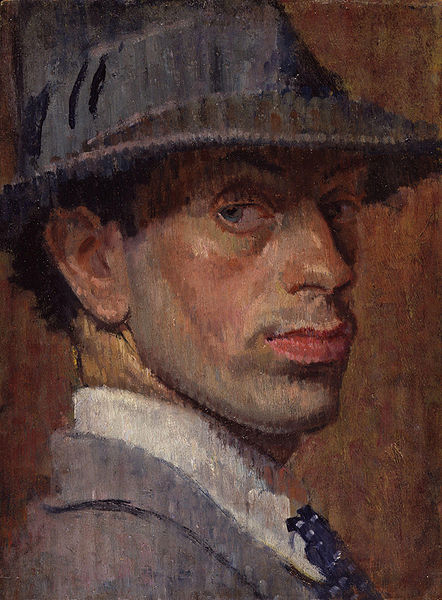 David Bomberg,
David Bomberg,, Stephen Winsten, John Rodker
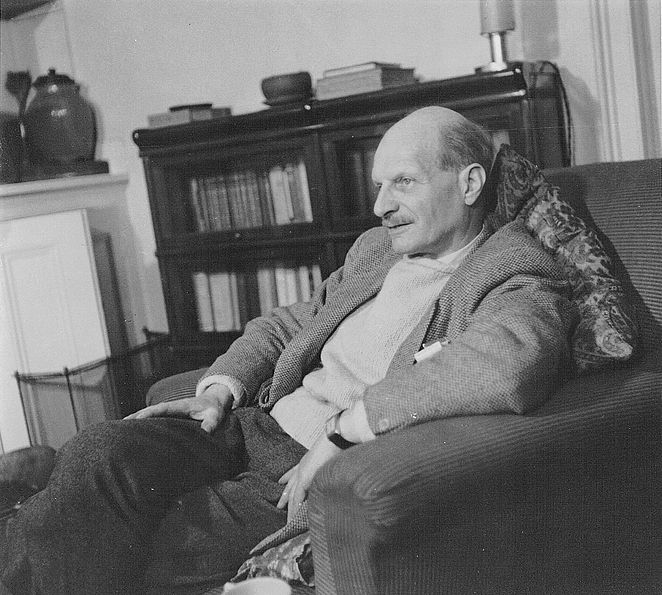 and its only female member, Clare Winsten (Clara Birnberg).
and its only female member, Clare Winsten (Clara Birnberg).  The name is modern, and not a contemporary, one, originating later in the 20th century.
The name is modern, and not a contemporary, one, originating later in the 20th century.
Bomberg was one of the most audacious of the exceptional generation of artists who studied at the Slade School of Art under Henry Tonks, and which included Mark Gertler,
and which included Mark Gertler, Stanley Spencer, C.R.W. Nevinson and Dora Carrington.
Stanley Spencer, C.R.W. Nevinson and Dora Carrington. Bomberg painted a series of complex geometric compositions combining the influences of cubism and futurism in the years immediately preceding
Bomberg painted a series of complex geometric compositions combining the influences of cubism and futurism in the years immediately preceding World War I; typically using a limited number of striking colours, turning humans into simple, angular shapes,
World War I; typically using a limited number of striking colours, turning humans into simple, angular shapes, and sometimes overlaying the whole painting a strong grid-work colouring scheme. He was expelled from the Slade School of Art in 1913,
and sometimes overlaying the whole painting a strong grid-work colouring scheme. He was expelled from the Slade School of Art in 1913, with agreement between the senior teachers Tonks, Frederick Brown and
with agreement between the senior teachers Tonks, Frederick Brown and  Philip Wilson Steer, because of the audacity of his breach from the conventional approach of that time.
Philip Wilson Steer, because of the audacity of his breach from the conventional approach of that time.
 and which included Mark Gertler,
and which included Mark Gertler, Stanley Spencer, C.R.W. Nevinson and Dora Carrington.
Stanley Spencer, C.R.W. Nevinson and Dora Carrington. Bomberg painted a series of complex geometric compositions combining the influences of cubism and futurism in the years immediately preceding
Bomberg painted a series of complex geometric compositions combining the influences of cubism and futurism in the years immediately preceding World War I; typically using a limited number of striking colours, turning humans into simple, angular shapes,
World War I; typically using a limited number of striking colours, turning humans into simple, angular shapes, and sometimes overlaying the whole painting a strong grid-work colouring scheme. He was expelled from the Slade School of Art in 1913,
and sometimes overlaying the whole painting a strong grid-work colouring scheme. He was expelled from the Slade School of Art in 1913, with agreement between the senior teachers Tonks, Frederick Brown and
with agreement between the senior teachers Tonks, Frederick Brown and  Philip Wilson Steer, because of the audacity of his breach from the conventional approach of that time.
Philip Wilson Steer, because of the audacity of his breach from the conventional approach of that time.
Whether because his faith in the machine age had been shattered by his experiences as a private soldier in the trenches(below his friend rosenburg killed in action He died on the Somme in 1918 at the age of 27..) or because of the pervasive retrogressive attitude towards modernism in Britain Bomberg moved to a
or because of the pervasive retrogressive attitude towards modernism in Britain Bomberg moved to a  more figurative style in the 1920s and his work became increasingly dominated by portraits and landscapes drawn from nature. Gradually developing a more expressionist technique he travelled widely through the Middle East and Europe.
more figurative style in the 1920s and his work became increasingly dominated by portraits and landscapes drawn from nature. Gradually developing a more expressionist technique he travelled widely through the Middle East and Europe.
In 1922 he Visited Lugano with Alice to stay and paint with Ben and Winifred Nicholson. Nicholson's willingness to extend hospitality to Bomberg was a reflection of the high standing he still enjoyed among experimental artists. But the trip was a "great fiasco" according to Alice: 'David hated being hauled out in the snow on painting expeditions, expected to play the maestro and teach them how to paint. Finally their was a show-down and they paid our fares home glad to get rid of us!'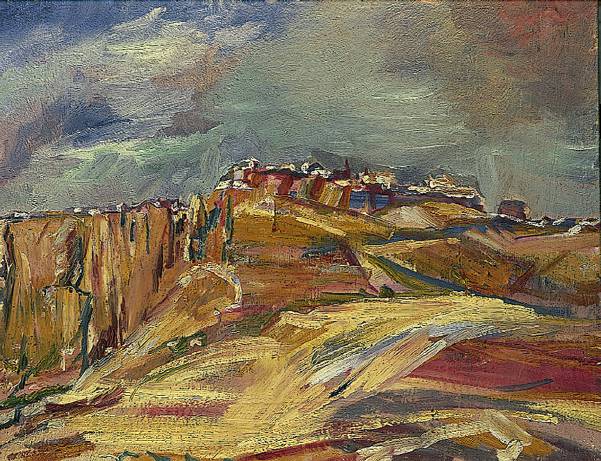
 or because of the pervasive retrogressive attitude towards modernism in Britain Bomberg moved to a
or because of the pervasive retrogressive attitude towards modernism in Britain Bomberg moved to a  more figurative style in the 1920s and his work became increasingly dominated by portraits and landscapes drawn from nature. Gradually developing a more expressionist technique he travelled widely through the Middle East and Europe.
more figurative style in the 1920s and his work became increasingly dominated by portraits and landscapes drawn from nature. Gradually developing a more expressionist technique he travelled widely through the Middle East and Europe.
In 1922 he Visited Lugano with Alice to stay and paint with Ben and Winifred Nicholson. Nicholson's willingness to extend hospitality to Bomberg was a reflection of the high standing he still enjoyed among experimental artists. But the trip was a "great fiasco" according to Alice: 'David hated being hauled out in the snow on painting expeditions, expected to play the maestro and teach them how to paint. Finally their was a show-down and they paid our fares home glad to get rid of us!'

From 1945 to 1953, he worked as a teacher at  Borough Polytechnic (now London South Bank University) in London, where his pupils included Frank Auerbach
Borough Polytechnic (now London South Bank University) in London, where his pupils included Frank Auerbach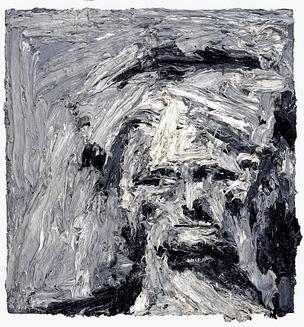 , Leon Kossoff
, Leon Kossoff , Cliff Holden, Dorothy Mead
, Cliff Holden, Dorothy Mead , Gustav Metzger
, Gustav Metzger , Dennis Creffield, and Miles Richmond.
, Dennis Creffield, and Miles Richmond.
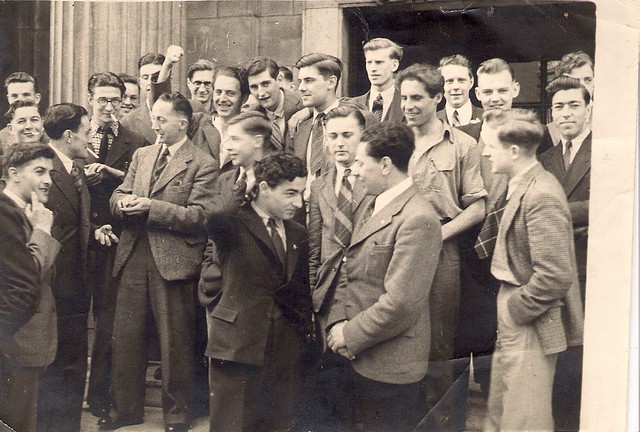 David Bomberg House, one of the student halls of residences at London South Bank University, is named in his honour.In July 1953 in a catalogue essay for a forthcoming exhibition of work by his students, the Borough Bottega, Bomberg wrote a manifesto which encapsulated his concerns with man's spiritual existence, discussed the artist's approach to form and addressed the legacy of Cézanne.
David Bomberg House, one of the student halls of residences at London South Bank University, is named in his honour.In July 1953 in a catalogue essay for a forthcoming exhibition of work by his students, the Borough Bottega, Bomberg wrote a manifesto which encapsulated his concerns with man's spiritual existence, discussed the artist's approach to form and addressed the legacy of Cézanne. Writing of 'the meaning of drawing and how it is related to the interpretation of form' and 'the study of structure', Bomberg proposed that 'the approach to mass' depended on the individual's own freedom: to draw a subject was more than merely a response to 'the organic character of mass', but was also spurred by a belief that 'we have urgent need of the affirmation of [man's] spiritual significance and his individuality'.Personal and spiritual dimensions found powerful expression not just in Bomberg's landscapes but also in his drawings of French churches, which date from the same year that he was formulating these ideas. David Bomberg’s charcoal drawing of 1945, entitled Evening in the City of London, which is in the prints and drawings collection of Ashmolean Museum in Oxford.
Writing of 'the meaning of drawing and how it is related to the interpretation of form' and 'the study of structure', Bomberg proposed that 'the approach to mass' depended on the individual's own freedom: to draw a subject was more than merely a response to 'the organic character of mass', but was also spurred by a belief that 'we have urgent need of the affirmation of [man's] spiritual significance and his individuality'.Personal and spiritual dimensions found powerful expression not just in Bomberg's landscapes but also in his drawings of French churches, which date from the same year that he was formulating these ideas. David Bomberg’s charcoal drawing of 1945, entitled Evening in the City of London, which is in the prints and drawings collection of Ashmolean Museum in Oxford.
 Borough Polytechnic (now London South Bank University) in London, where his pupils included Frank Auerbach
Borough Polytechnic (now London South Bank University) in London, where his pupils included Frank Auerbach , Leon Kossoff
, Leon Kossoff , Cliff Holden, Dorothy Mead
, Cliff Holden, Dorothy Mead , Gustav Metzger
, Gustav Metzger , Dennis Creffield, and Miles Richmond.
, Dennis Creffield, and Miles Richmond.
 David Bomberg House, one of the student halls of residences at London South Bank University, is named in his honour.In July 1953 in a catalogue essay for a forthcoming exhibition of work by his students, the Borough Bottega, Bomberg wrote a manifesto which encapsulated his concerns with man's spiritual existence, discussed the artist's approach to form and addressed the legacy of Cézanne.
David Bomberg House, one of the student halls of residences at London South Bank University, is named in his honour.In July 1953 in a catalogue essay for a forthcoming exhibition of work by his students, the Borough Bottega, Bomberg wrote a manifesto which encapsulated his concerns with man's spiritual existence, discussed the artist's approach to form and addressed the legacy of Cézanne. Writing of 'the meaning of drawing and how it is related to the interpretation of form' and 'the study of structure', Bomberg proposed that 'the approach to mass' depended on the individual's own freedom: to draw a subject was more than merely a response to 'the organic character of mass', but was also spurred by a belief that 'we have urgent need of the affirmation of [man's] spiritual significance and his individuality'.Personal and spiritual dimensions found powerful expression not just in Bomberg's landscapes but also in his drawings of French churches, which date from the same year that he was formulating these ideas. David Bomberg’s charcoal drawing of 1945, entitled Evening in the City of London, which is in the prints and drawings collection of Ashmolean Museum in Oxford.
Writing of 'the meaning of drawing and how it is related to the interpretation of form' and 'the study of structure', Bomberg proposed that 'the approach to mass' depended on the individual's own freedom: to draw a subject was more than merely a response to 'the organic character of mass', but was also spurred by a belief that 'we have urgent need of the affirmation of [man's] spiritual significance and his individuality'.Personal and spiritual dimensions found powerful expression not just in Bomberg's landscapes but also in his drawings of French churches, which date from the same year that he was formulating these ideas. David Bomberg’s charcoal drawing of 1945, entitled Evening in the City of London, which is in the prints and drawings collection of Ashmolean Museum in Oxford.
Like many another wartime Londoner, Bomberg was struck by the seemingly miraculous way in which Christopher Wren’s great cathedral of St Paul’s had survived the incessant bombing attacks of the Nazis. He took care to show the cathedral from a distance, framed by the desolation around it. According to the artist’s wife, Lilian Bomberg, “He got permission to climb to the top of a church, in Cheapside, I think, and painted St Paul’s from its east side.” The church in question was probably St Bride’s.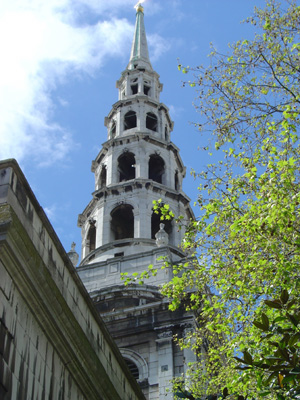 Access to public buildings deemed to be prime targets for enemy attack was severely restricted. “There was always an element of danger,” Lilian Bomberg recalled, because “we didn’t know when the raids were taking place. David went out in spite of this. He did worry about it, and it interfered with his drawing.The artist David Piper curtly described the work reproduced on this page as “the finest picture” of London in wartime. In his biography of Bomberg, published in 1987, Richard Cork was more expansive: “Contours are scored on to the paper with a charcoal sooty enough to have been seized, still smouldering, from the burnt-out wreckage of a bombsite. Bomberg sees the cityscape as a sequence of eerily deserted containers, no more than a skeleton of the metropolis that he knew before Hitler’s raids pummelled the area so grievously. The advent of evening spreads shadows across these uninhabited spaces, intensifying their gutted desolation. But church towers still punctuate the charred ruins, and Bomberg ensures that the distant cathedral rises with proud, substantial conviction on the horizon.
Access to public buildings deemed to be prime targets for enemy attack was severely restricted. “There was always an element of danger,” Lilian Bomberg recalled, because “we didn’t know when the raids were taking place. David went out in spite of this. He did worry about it, and it interfered with his drawing.The artist David Piper curtly described the work reproduced on this page as “the finest picture” of London in wartime. In his biography of Bomberg, published in 1987, Richard Cork was more expansive: “Contours are scored on to the paper with a charcoal sooty enough to have been seized, still smouldering, from the burnt-out wreckage of a bombsite. Bomberg sees the cityscape as a sequence of eerily deserted containers, no more than a skeleton of the metropolis that he knew before Hitler’s raids pummelled the area so grievously. The advent of evening spreads shadows across these uninhabited spaces, intensifying their gutted desolation. But church towers still punctuate the charred ruins, and Bomberg ensures that the distant cathedral rises with proud, substantial conviction on the horizon.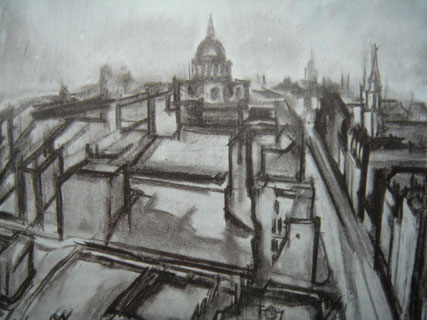
 Access to public buildings deemed to be prime targets for enemy attack was severely restricted. “There was always an element of danger,” Lilian Bomberg recalled, because “we didn’t know when the raids were taking place. David went out in spite of this. He did worry about it, and it interfered with his drawing.The artist David Piper curtly described the work reproduced on this page as “the finest picture” of London in wartime. In his biography of Bomberg, published in 1987, Richard Cork was more expansive: “Contours are scored on to the paper with a charcoal sooty enough to have been seized, still smouldering, from the burnt-out wreckage of a bombsite. Bomberg sees the cityscape as a sequence of eerily deserted containers, no more than a skeleton of the metropolis that he knew before Hitler’s raids pummelled the area so grievously. The advent of evening spreads shadows across these uninhabited spaces, intensifying their gutted desolation. But church towers still punctuate the charred ruins, and Bomberg ensures that the distant cathedral rises with proud, substantial conviction on the horizon.
Access to public buildings deemed to be prime targets for enemy attack was severely restricted. “There was always an element of danger,” Lilian Bomberg recalled, because “we didn’t know when the raids were taking place. David went out in spite of this. He did worry about it, and it interfered with his drawing.The artist David Piper curtly described the work reproduced on this page as “the finest picture” of London in wartime. In his biography of Bomberg, published in 1987, Richard Cork was more expansive: “Contours are scored on to the paper with a charcoal sooty enough to have been seized, still smouldering, from the burnt-out wreckage of a bombsite. Bomberg sees the cityscape as a sequence of eerily deserted containers, no more than a skeleton of the metropolis that he knew before Hitler’s raids pummelled the area so grievously. The advent of evening spreads shadows across these uninhabited spaces, intensifying their gutted desolation. But church towers still punctuate the charred ruins, and Bomberg ensures that the distant cathedral rises with proud, substantial conviction on the horizon.
to others such as the present work which are altogether more mysterious and atmospheric. In Notre Dame Cathedral, Paris it is as though the artist has taken the cathedral apart, only to rebuild it again, stripping it of all but its most essential structural components. The heavy bulk of the cathedral is reduced to a light skeleton and the building glimmers to life from out of the twilight, yet the result still possesses an imposing grandeur.
 There is a painting on each side of this work above. Both were made on the same evening during one of Bomberg’s classes at Borough Polytechnic. Michelmore, one of his students, started both from the same model and Bomberg took over. In this image, the teacher added the hair and started the white sheet at the bottom. The background (top right) shows how he encouraged students at the end of the evening to clean excess paint onto the board to make the image appear more complete.
There is a painting on each side of this work above. Both were made on the same evening during one of Bomberg’s classes at Borough Polytechnic. Michelmore, one of his students, started both from the same model and Bomberg took over. In this image, the teacher added the hair and started the white sheet at the bottom. The background (top right) shows how he encouraged students at the end of the evening to clean excess paint onto the board to make the image appear more complete.
Though the model was female, the title suggests the limp body of the dead Christ .Both sides of this painting were begun and completed during a single evening's session in one of the life  classes taught by Bomberg at the Borough Polytechnic. In both pictures the view is from the same
classes taught by Bomberg at the Borough Polytechnic. In both pictures the view is from the same  position downwards towards the same female model, who is lying on a mattress, with a sheet at lower left(Rachelle Bomberg niece of david))
position downwards towards the same female model, who is lying on a mattress, with a sheet at lower left(Rachelle Bomberg niece of david)) David Bomberg )
David Bomberg )
 classes taught by Bomberg at the Borough Polytechnic. In both pictures the view is from the same
classes taught by Bomberg at the Borough Polytechnic. In both pictures the view is from the same  position downwards towards the same female model, who is lying on a mattress, with a sheet at lower left(Rachelle Bomberg niece of david))
position downwards towards the same female model, who is lying on a mattress, with a sheet at lower left(Rachelle Bomberg niece of david)) David Bomberg )
David Bomberg )
Richard Michelmore became a student at the Bartlett School of Architecture, University College, London, in September 1945. At that time Bomberg had just been engaged by the Bartlett to take a class in freehand drawing on Saturday mornings. As there were 120 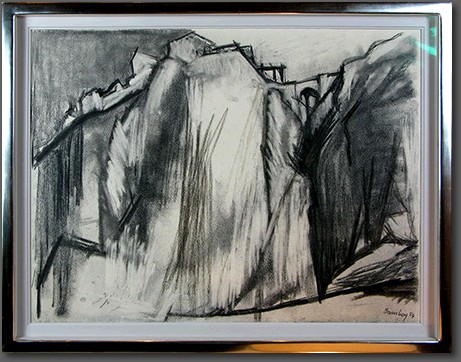 students in the first year, they attended these classes in groups of twenty, each group going every sixth Saturday. The earliest of these classes of Bomberg's that Michelmore attended were held in the Cast Courts at the Victoria and Albert Museum.
students in the first year, they attended these classes in groups of twenty, each group going every sixth Saturday. The earliest of these classes of Bomberg's that Michelmore attended were held in the Cast Courts at the Victoria and Albert Museum. He owns drawings executed jointly by Bomberg and himself of the Temple, Temple Church, Westminster Bridge and the interior of Westminster Abbey. In 1949, after leaving the Bartlett, Michelmore began to attend Bomberg's life classes held in the evenings at the Borough Polytechnic. He continued to attend them regularly until Bomberg left for Ronda in 1954. From 1953 to 1955 he studied at Kingston Polytechnic where he qualified as an architect
He owns drawings executed jointly by Bomberg and himself of the Temple, Temple Church, Westminster Bridge and the interior of Westminster Abbey. In 1949, after leaving the Bartlett, Michelmore began to attend Bomberg's life classes held in the evenings at the Borough Polytechnic. He continued to attend them regularly until Bomberg left for Ronda in 1954. From 1953 to 1955 he studied at Kingston Polytechnic where he qualified as an architect
 students in the first year, they attended these classes in groups of twenty, each group going every sixth Saturday. The earliest of these classes of Bomberg's that Michelmore attended were held in the Cast Courts at the Victoria and Albert Museum.
students in the first year, they attended these classes in groups of twenty, each group going every sixth Saturday. The earliest of these classes of Bomberg's that Michelmore attended were held in the Cast Courts at the Victoria and Albert Museum.
Michelmore found Bomberg (who always called him ‘Micklemore’) enormously encouraging. Bomberg believed in allowing a student to take a painting quite far according to the student's own conception. On occasion, however, he would take over a student's brushes and work on the painting himself. He did this on both sides of the present work. 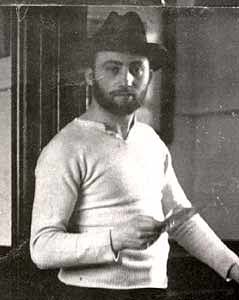 On the recto (the side in which the parting in the model's hair is the more clearly defined) Bomberg painted the hair, explaining that while local colour was not of concern in itself it could help to identify the image. Bomberg also painted the start of the edging of the white sheet, which he told
On the recto (the side in which the parting in the model's hair is the more clearly defined) Bomberg painted the hair, explaining that while local colour was not of concern in itself it could help to identify the image. Bomberg also painted the start of the edging of the white sheet, which he told  Michelmore to complete. On the verso, Bomberg drew into the paint with the tip of the brush handle, to outline the form of the figure.At the end of a painting session,
Michelmore to complete. On the verso, Bomberg drew into the paint with the tip of the brush handle, to outline the form of the figure.At the end of a painting session,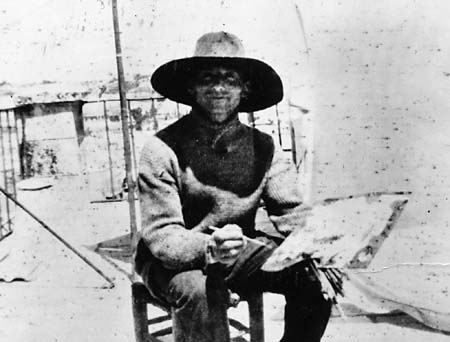 Bomberg would sometimes recommend that a student clean his brushes on unpainted areas of the background in order to give the picture more of the look of a finished work; this partly explains the marks at top right of the recto of the present work.
Bomberg would sometimes recommend that a student clean his brushes on unpainted areas of the background in order to give the picture more of the look of a finished work; this partly explains the marks at top right of the recto of the present work. It was not Michelmore's custom to sign his paintings, but at Bomberg's insistence both sides of this work were signed by both artists; Michelmore cannot recall another instance of this happening.
It was not Michelmore's custom to sign his paintings, but at Bomberg's insistence both sides of this work were signed by both artists; Michelmore cannot recall another instance of this happening. Both sides were signed in the life studio on the evening they were painted; Bomberg had to show Michelmore how to paint his signature. Bomberg felt the work should be exhibited, and himself painted the old frame, which Michelmore obtained and which still surrounds the work. Michelmore and other students could not afford artists' materials. In the present work paint powder bought by Michelmore in packets from a builder's ironmonger on Euston Road was mixed, on the palette, with linseed oil.
Both sides were signed in the life studio on the evening they were painted; Bomberg had to show Michelmore how to paint his signature. Bomberg felt the work should be exhibited, and himself painted the old frame, which Michelmore obtained and which still surrounds the work. Michelmore and other students could not afford artists' materials. In the present work paint powder bought by Michelmore in packets from a builder's ironmonger on Euston Road was mixed, on the palette, with linseed oil.
 On the recto (the side in which the parting in the model's hair is the more clearly defined) Bomberg painted the hair, explaining that while local colour was not of concern in itself it could help to identify the image. Bomberg also painted the start of the edging of the white sheet, which he told
On the recto (the side in which the parting in the model's hair is the more clearly defined) Bomberg painted the hair, explaining that while local colour was not of concern in itself it could help to identify the image. Bomberg also painted the start of the edging of the white sheet, which he told  Michelmore to complete. On the verso, Bomberg drew into the paint with the tip of the brush handle, to outline the form of the figure.At the end of a painting session,
Michelmore to complete. On the verso, Bomberg drew into the paint with the tip of the brush handle, to outline the form of the figure.At the end of a painting session, Bomberg would sometimes recommend that a student clean his brushes on unpainted areas of the background in order to give the picture more of the look of a finished work; this partly explains the marks at top right of the recto of the present work.
Bomberg would sometimes recommend that a student clean his brushes on unpainted areas of the background in order to give the picture more of the look of a finished work; this partly explains the marks at top right of the recto of the present work. It was not Michelmore's custom to sign his paintings, but at Bomberg's insistence both sides of this work were signed by both artists; Michelmore cannot recall another instance of this happening.
It was not Michelmore's custom to sign his paintings, but at Bomberg's insistence both sides of this work were signed by both artists; Michelmore cannot recall another instance of this happening. Both sides were signed in the life studio on the evening they were painted; Bomberg had to show Michelmore how to paint his signature. Bomberg felt the work should be exhibited, and himself painted the old frame, which Michelmore obtained and which still surrounds the work. Michelmore and other students could not afford artists' materials. In the present work paint powder bought by Michelmore in packets from a builder's ironmonger on Euston Road was mixed, on the palette, with linseed oil.
Both sides were signed in the life studio on the evening they were painted; Bomberg had to show Michelmore how to paint his signature. Bomberg felt the work should be exhibited, and himself painted the old frame, which Michelmore obtained and which still surrounds the work. Michelmore and other students could not afford artists' materials. In the present work paint powder bought by Michelmore in packets from a builder's ironmonger on Euston Road was mixed, on the palette, with linseed oil.
Expelled from the Slade in the Summer of 1913, Bomberg formed a series of loose affiliations with several groups involved with the contemporary English avant-garde, embarking on a brief and acrimonious association with the Bloomsbury Group's Omega Workshops before exhibiting with the Camden Town Group in December 1913.The Camden Town Group was a group of English Post-Impressionist artists active 1911-1913.
Bloomsbury Group's Omega Workshops before exhibiting with the Camden Town Group in December 1913.The Camden Town Group was a group of English Post-Impressionist artists active 1911-1913.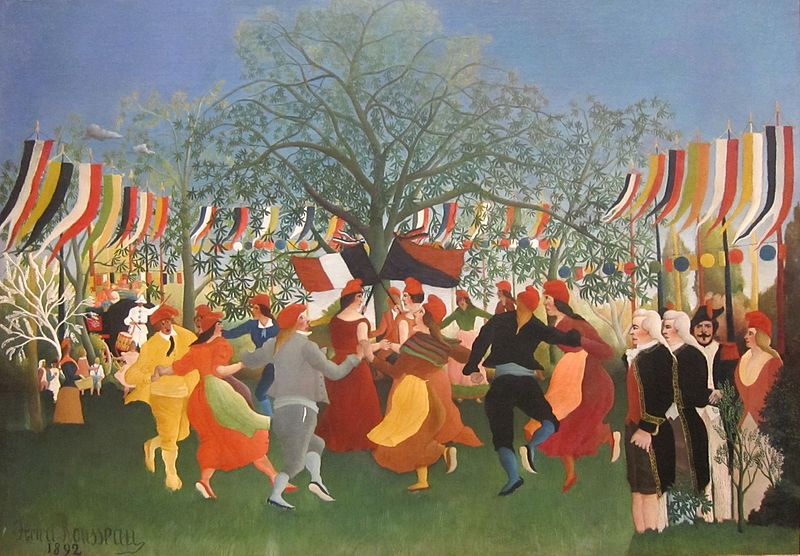 They gathered frequently at the studio of painter Walter Sickert in the Camden Town area of London His enthusiasm for the dynamism and aesthetics of the machine age gave him a
They gathered frequently at the studio of painter Walter Sickert in the Camden Town area of London His enthusiasm for the dynamism and aesthetics of the machine age gave him a  natural affinity with Wyndham Lewis's emerging vorticist movement, and five of his works featured in the founding exhibition of the London Group in 1914,the members of the Camden Town Group included Walter Sickert, Harold Gilman,
natural affinity with Wyndham Lewis's emerging vorticist movement, and five of his works featured in the founding exhibition of the London Group in 1914,the members of the Camden Town Group included Walter Sickert, Harold Gilman, Spencer Frederick Gore
Spencer Frederick Gore ,Lucien Pissarro (the son of French Impressionist painter Camille Pissarro)
,Lucien Pissarro (the son of French Impressionist painter Camille Pissarro) , Wyndham Lewis, Walter Bayes, J.B. Manson,
, Wyndham Lewis, Walter Bayes, J.B. Manson, Robert Bevan
Robert Bevan ,Augustus John, Henry Lamb, and Charles Ginner. but BOMBERG's own artistic vision led him quickly to distance himself from the vorticists' organisation. In July 1914 he refused any involvement in the vorticist literary magazine BLAST
,Augustus John, Henry Lamb, and Charles Ginner. but BOMBERG's own artistic vision led him quickly to distance himself from the vorticists' organisation. In July 1914 he refused any involvement in the vorticist literary magazine BLAST  and in June of the following year his work featured only in the "Invited to show" section of the vorticist exhibition at London's Dore Gallery.
and in June of the following year his work featured only in the "Invited to show" section of the vorticist exhibition at London's Dore Gallery.
 Bloomsbury Group's Omega Workshops before exhibiting with the Camden Town Group in December 1913.The Camden Town Group was a group of English Post-Impressionist artists active 1911-1913.
Bloomsbury Group's Omega Workshops before exhibiting with the Camden Town Group in December 1913.The Camden Town Group was a group of English Post-Impressionist artists active 1911-1913. They gathered frequently at the studio of painter Walter Sickert in the Camden Town area of London His enthusiasm for the dynamism and aesthetics of the machine age gave him a
They gathered frequently at the studio of painter Walter Sickert in the Camden Town area of London His enthusiasm for the dynamism and aesthetics of the machine age gave him a  natural affinity with Wyndham Lewis's emerging vorticist movement, and five of his works featured in the founding exhibition of the London Group in 1914,the members of the Camden Town Group included Walter Sickert, Harold Gilman,
natural affinity with Wyndham Lewis's emerging vorticist movement, and five of his works featured in the founding exhibition of the London Group in 1914,the members of the Camden Town Group included Walter Sickert, Harold Gilman, Spencer Frederick Gore
Spencer Frederick Gore ,Lucien Pissarro (the son of French Impressionist painter Camille Pissarro)
,Lucien Pissarro (the son of French Impressionist painter Camille Pissarro) , Wyndham Lewis, Walter Bayes, J.B. Manson,
, Wyndham Lewis, Walter Bayes, J.B. Manson, Robert Bevan
Robert Bevan ,Augustus John, Henry Lamb, and Charles Ginner. but BOMBERG's own artistic vision led him quickly to distance himself from the vorticists' organisation. In July 1914 he refused any involvement in the vorticist literary magazine BLAST
,Augustus John, Henry Lamb, and Charles Ginner. but BOMBERG's own artistic vision led him quickly to distance himself from the vorticists' organisation. In July 1914 he refused any involvement in the vorticist literary magazine BLAST  and in June of the following year his work featured only in the "Invited to show" section of the vorticist exhibition at London's Dore Gallery.
and in June of the following year his work featured only in the "Invited to show" section of the vorticist exhibition at London's Dore Gallery.
1914 saw the highpoint of his early career — a solo exhibition at the Chenil Gallery in Chelsea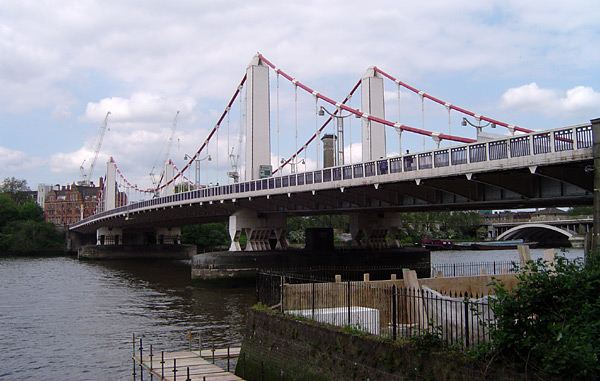 which attracted positive reviews from Roger Fryand T. E. Hulme and attracted favourable attention from experimental artists nationally and internationally.The exhibition featured several of Bomberg's early masterpieces, most notably The Mud Bath (1914)
which attracted positive reviews from Roger Fryand T. E. Hulme and attracted favourable attention from experimental artists nationally and internationally.The exhibition featured several of Bomberg's early masterpieces, most notably The Mud Bath (1914)  which was hung on an outside wall surrounded by Union Flags — causing "the horses drawing the 29 bus... to shy at it as they came round the corner of King's Road."
which was hung on an outside wall surrounded by Union Flags — causing "the horses drawing the 29 bus... to shy at it as they came round the corner of King's Road."
 which attracted positive reviews from Roger Fryand T. E. Hulme and attracted favourable attention from experimental artists nationally and internationally.The exhibition featured several of Bomberg's early masterpieces, most notably The Mud Bath (1914)
which attracted positive reviews from Roger Fryand T. E. Hulme and attracted favourable attention from experimental artists nationally and internationally.The exhibition featured several of Bomberg's early masterpieces, most notably The Mud Bath (1914)  which was hung on an outside wall surrounded by Union Flags — causing "the horses drawing the 29 bus... to shy at it as they came round the corner of King's Road."
which was hung on an outside wall surrounded by Union Flags — causing "the horses drawing the 29 bus... to shy at it as they came round the corner of King's Road.""I look upon Nature while I live in a steel city" he explained in the exhibition catalogue "I APPEAL to a Sense of Form ... My object is the construction of Pure Form. I reject everything in painting that is not Pure Form."
With the help of Augustus John, Bomberg sold two paintings from this exhibition to the influential American collector John Quinn.
Despite the success of his Chenil Gallery exhibition Bomberg continued to be dogged by financial problems.Asin his wartime service on the western front stated David had an obvious awakening as regards life In 1915, he had enlisted in the Royal Engineers but later transferring in 1916 to the King's Royal Rifle Corps and in the March of that year, shortly after marrying his first wife, he was sent to the Western Front.(rosenburg below)

His experiences of its mechanized slaughter and the death of his brother in the trenches — as well as those of his friend Isaac Rosenberg changed the artist forever. and his supporter T. E. Hulme
and his supporter T. E. Hulme  —and permanently destroyed his faith in the aesthetics of the machine age.
—and permanently destroyed his faith in the aesthetics of the machine age.  This can be seen most clearly in his commission for the Canadian War Memorials Fund, that is below.Sappers at Work (1918–1919): his first version of the painting was dismissed as a "futurist abortion" and was replaced by a second far more representational version.
This can be seen most clearly in his commission for the Canadian War Memorials Fund, that is below.Sappers at Work (1918–1919): his first version of the painting was dismissed as a "futurist abortion" and was replaced by a second far more representational version.
 and his supporter T. E. Hulme
and his supporter T. E. Hulme  —and permanently destroyed his faith in the aesthetics of the machine age.
—and permanently destroyed his faith in the aesthetics of the machine age.  This can be seen most clearly in his commission for the Canadian War Memorials Fund, that is below.Sappers at Work (1918–1919): his first version of the painting was dismissed as a "futurist abortion" and was replaced by a second far more representational version.
This can be seen most clearly in his commission for the Canadian War Memorials Fund, that is below.Sappers at Work (1918–1919): his first version of the painting was dismissed as a "futurist abortion" and was replaced by a second far more representational version.
The artist's book Russian Ballet, 1919, was the last work to use the pre-war vorticist idiom. Bomberg self-published this work whilst waiting for the Canadian Government's verdict on Sappers At Work;
1919, was the last work to use the pre-war vorticist idiom. Bomberg self-published this work whilst waiting for the Canadian Government's verdict on Sappers At Work; Sappers
Sappers
the next few years was to see him 'experimenting with ways of making his stark pre-war style more rounded and organic'.Russian Ballet i published in 1919 describes the impact of seeing a performance of Diaghilev's Ballets Russes, and is based on a series of drawings Bomberg had done around 1914, whilst associated with the Vorticist group of avant-garde artists in London. The only surviving example of a vorticist artist's book, the work can be seen as a parody of Marinetti's seminal futurist book Zang Tumb Tumb, using similar language to the Italian's work glorifying war, but instead praising the impact of watching the decidedly less macho Ballets Russes in full flow.
 1919, was the last work to use the pre-war vorticist idiom. Bomberg self-published this work whilst waiting for the Canadian Government's verdict on Sappers At Work;
1919, was the last work to use the pre-war vorticist idiom. Bomberg self-published this work whilst waiting for the Canadian Government's verdict on Sappers At Work; Sappers
Sappersthe next few years was to see him 'experimenting with ways of making his stark pre-war style more rounded and organic'.Russian Ballet i published in 1919 describes the impact of seeing a performance of Diaghilev's Ballets Russes, and is based on a series of drawings Bomberg had done around 1914, whilst associated with the Vorticist group of avant-garde artists in London. The only surviving example of a vorticist artist's book, the work can be seen as a parody of Marinetti's seminal futurist book Zang Tumb Tumb, using similar language to the Italian's work glorifying war, but instead praising the impact of watching the decidedly less macho Ballets Russes in full flow.

The book was the last time that Bomberg would work in a vorticist idiom. After witnessing the carnage of the First World War at first hand, he was to lose his faith in modernism and instead develop a looser, expressive style, based predominantly around landscapes.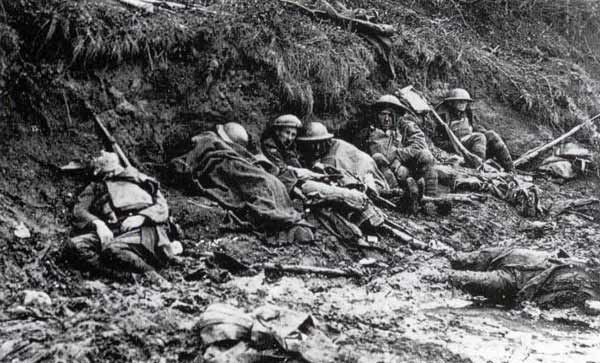

In radical opposition to the prevailing currents in avant-garde art, stimulated as these were by the enthusiasm for mechanization in Constructivism in Russia following the Revolution,  Bomberg went to paint and draw in Palestine between 1923 and 1927, with the assistance of the Zionist Organization.He Settled in Jerusalem where they remained until the autumn of 1927, renting a house in the hills. This period was a crucial turning point for him; painting landscapes in the open air. Once landscape imagery took hold of Bomberg's imagination humanity never regained the position it had previously occupied in his work. The landscapes and city views painted during this period seem diametrically opposite to Bomberg's pre-war vision; alongside small studies of Jerusalem and Petra which retain all his previous vivacity, other paintings are based on a mimetic approach, a close and meticulous study of nature; they are almost topographical in their fidelity to an observed view, and only the firmness of the overall structure links them with his earlier work. There he brought together the geometric energies of his pre-war work as an "English cubist" with the tradition of figurative observation of the English landscape school of Turner, Constable, Girtin and Cottman.
Bomberg went to paint and draw in Palestine between 1923 and 1927, with the assistance of the Zionist Organization.He Settled in Jerusalem where they remained until the autumn of 1927, renting a house in the hills. This period was a crucial turning point for him; painting landscapes in the open air. Once landscape imagery took hold of Bomberg's imagination humanity never regained the position it had previously occupied in his work. The landscapes and city views painted during this period seem diametrically opposite to Bomberg's pre-war vision; alongside small studies of Jerusalem and Petra which retain all his previous vivacity, other paintings are based on a mimetic approach, a close and meticulous study of nature; they are almost topographical in their fidelity to an observed view, and only the firmness of the overall structure links them with his earlier work. There he brought together the geometric energies of his pre-war work as an "English cubist" with the tradition of figurative observation of the English landscape school of Turner, Constable, Girtin and Cottman.
 Bomberg went to paint and draw in Palestine between 1923 and 1927, with the assistance of the Zionist Organization.He Settled in Jerusalem where they remained until the autumn of 1927, renting a house in the hills. This period was a crucial turning point for him; painting landscapes in the open air. Once landscape imagery took hold of Bomberg's imagination humanity never regained the position it had previously occupied in his work. The landscapes and city views painted during this period seem diametrically opposite to Bomberg's pre-war vision; alongside small studies of Jerusalem and Petra which retain all his previous vivacity, other paintings are based on a mimetic approach, a close and meticulous study of nature; they are almost topographical in their fidelity to an observed view, and only the firmness of the overall structure links them with his earlier work. There he brought together the geometric energies of his pre-war work as an "English cubist" with the tradition of figurative observation of the English landscape school of Turner, Constable, Girtin and Cottman.
Bomberg went to paint and draw in Palestine between 1923 and 1927, with the assistance of the Zionist Organization.He Settled in Jerusalem where they remained until the autumn of 1927, renting a house in the hills. This period was a crucial turning point for him; painting landscapes in the open air. Once landscape imagery took hold of Bomberg's imagination humanity never regained the position it had previously occupied in his work. The landscapes and city views painted during this period seem diametrically opposite to Bomberg's pre-war vision; alongside small studies of Jerusalem and Petra which retain all his previous vivacity, other paintings are based on a mimetic approach, a close and meticulous study of nature; they are almost topographical in their fidelity to an observed view, and only the firmness of the overall structure links them with his earlier work. There he brought together the geometric energies of his pre-war work as an "English cubist" with the tradition of figurative observation of the English landscape school of Turner, Constable, Girtin and Cottman.
Bomberg's superb draughtsmanship was expressed also in a lifelong series of portraits, from the early period of his Botticelli-like "Head of a Poet" (1913), a pencil portrait of his friend the poet Isaac Rosenberg for which he won the Henry Tonks Prize at the Slade, to his "Last Self-Portrait" (1956), painted at Ronda, a meditation also on Rembrandt.From there followed Bomberg's great period of painting and drawing in landscape, in Spain at Toledo (1928),  Ronda (1934–35 and 1954–57) andAsturias (1935), in Cyprus (1948) and intermittently in Britain, perhaps most powerfully in Cornwall.H e made his First trip to Spain, where, due to his admiration for El Greco, he settled for a few months in Toledo.
Ronda (1934–35 and 1954–57) andAsturias (1935), in Cyprus (1948) and intermittently in Britain, perhaps most powerfully in Cornwall.H e made his First trip to Spain, where, due to his admiration for El Greco, he settled for a few months in Toledo.
 Ronda (1934–35 and 1954–57) andAsturias (1935), in Cyprus (1948) and intermittently in Britain, perhaps most powerfully in Cornwall.H e made his First trip to Spain, where, due to his admiration for El Greco, he settled for a few months in Toledo.
Ronda (1934–35 and 1954–57) andAsturias (1935), in Cyprus (1948) and intermittently in Britain, perhaps most powerfully in Cornwall.H e made his First trip to Spain, where, due to his admiration for El Greco, he settled for a few months in Toledo.
The landscapes he created there arose from intense observation of the motif; however, the forms of the houses and the surrounding landscape were now charged with a new sense of personal urgency, as he allowed himself to fuse the close study of nature with his own passionately subjective response. Andrew forge justly observed of the Toledo canvases that 'an extraordinary strong personal note enters his work at this point; one seems to feel oneself breathing the artist's breath in front of some of these pictures.'H e then Spent the spring of 1930 in Morocco and the Greek Islands before returning to London ill with jaundice. Settled with Lilian Holt, also a painter.
Painted a remarkable set of portraits of Lilian and himself which exhibit a new vigor, insight and readiness to give the paint a boldly manipulated eloquence: a work such as 'Red Hat' demonstrates an especially eruptive desire to explore the possibilities of vehement mark-making.At about this time Bomberg was introduced to Arthur Willey who was buying pictures for three collectors in Bradford. Willey brought many paintings from Bomberg; this was one of the rare times that he ever had any substantial patronage or sales during his lifetime. It was these sales that made possible the ensuing trips to Russia and Spain.In 1933Encouraged by his sister Kitty and her husband James Newmark, both Bomberg and Lilian joined the Communist party.
Bomberg painted banners for demonstrations and attended mass unemployment rallies. In July they visited Russia for five months and gradually grew disillusioned with the Communist's effect on art. On return to London they resigned from the Communist Party.1934 came and he Left for Spain with Lilian, living first at Cuenca and then Ronda in Andalucia. In Cuenca, Bomberg's brushwork strove for a greater breadth, shedding the intricacy of the 1929 work in favor of a more summary and unified approach to form. As regards Ronda, being it is a fortress-like settlement on a mighty rocky plateau, which rears above the surroundings plain, it was an ideal place for an artist such as Bomberg who wanted to define nature's fundamental dynamism. Entering into a wholehearted engagement with a world riven by conclusive geological stress, he produced there a substantial body of work, most of the canvases employing a greater amount of impasto than before. Dinora, his only child was born.
In 1935 Moved to the Austrian Mountains, where Bomberg expected to be challenged by scenery more rugged and epic in its immensity than Ronda could provide.
The onset of internal dissensions in Spain became so alarming that the family hurried down the Santander in time to catch a boat for England just before the Civil War broke out.
The onset of internal dissensions in Spain became so alarming that the family hurried down the Santander in time to catch a boat for England just before the Civil War broke out.
1936June, one-man exhibition at the Cooling Gallery, which was treated with, disdain by most critics, largely ignored by reviewers and, moreover, didn't sell anything.
1937Turned to portraits of himself and his immediate family. Retrospective exhibition of 25 works with Margarete Hamerschlag and Horace Bodzky at the Foyle Art Gallery. From this date onwards exhibited in almost every annual London group exhibition until his death. Commissioned by the London Co-operative Societies' Joint Education Committee to 'design scenery and costumes' for a production of Handel's "Belshazzar": before the end of the year the project foundered, reinforcing Bomberg's dissatisfaction with Britain's inability to support its artists.
1939Took part in "Mural Painting in Great Britain: 1919-1939" at the Tate Gallery.
1940Married Lilian.
1942After his application as War Artist has been refused twice; Bomberg was commissioned by the War Artists Committee to produce a painting of an underground bomb store. Fascinated by the bombs stacked in the dis-used mines, he produced a large number of images, all showing his consciousness of the bombs' destructive purpose. The painting was rejected by the committee who then accepted three bomb store drawings.
1943Bomberg suffered increasingly from long periods of depression during which he was unable to paint but encouraged by Lilian, he began a series of flower paintings. The outcome was a group of paintings, which rejoiced in the exuberance of the blooms and the leaves thrusting their impetuous way out of the vases scarcely able to contain them, with vehemence reminiscent of the bomb-blasts so familiar to Londoners during the years of Hitler's blitz.
1944Taught drawing to gun crews in Hyde Park. Held various part-time teaching posts at Hammersmith, Battersea and Clapham.
1945-49Taught drawing one day a week at the Bartlett School of Architecture, London.
1945-53Taught drawing part-time at the Borough Polytechnic. Students included Leon Kossoff and Frank Auerbach. The Latter described his teacher as 'probably the most original, stubborn, radical intelligence that there was to be found in art schools' and added that in those classes there was an atmosphere of research and of radicalism which was extremely stimulating. For him teaching was a total activity and there are few paintings from these years.Those, which were produced, were mostly done during his visits to Devon and Cornwall in the summers of 1946 and 1947.
1947Foundation of the Borough Group. The Group held seven exhibitions between 1947 and its dissolution in 1950. The first exhibition was held at the Archer Gallery for which Bomberg wrote the forward to the catalogue 'Approach to Painting' but did not exhibit. He showed work in all their consecutive exhibitions.
1948Cliff Holden resigned from presidency of the Borough Group and Bomberg replaced him. Leslie Marr funded a painting trip to Cyprus for the whole family; Lillian, her daughter Dinora, Leslie who was married to Dinora, their daughter Juliet and the Bomberg's daughter Diana. Cyprus ' colours helped Bomberg to develop a more intense palette in works, which are often inflammatory in their impact. There he produced some of his finest landscapes but they were to be the last paintings Bomberg painted for four years.
1951Exhibited a few of the 1948 landscapes in the London Group show; in his review, John Berger declared that perhaps the most outstanding painting is a ravine landscape by David Bomberg. Bomberg's apparently careless and passionate use of paint adds weight and guts to it, one is thrilled by a brush mark as a juicy slash of paint and as a precise statement of the angle of declivity of a gully, seen through atmosphere.
1953-54Lived at Dinora's house where 'Mother of Venus' was painted during a temporary rift with Lilian.
1953Formation of the Borough Bottega at the Heffer Gallery Cambridge. Moved with Lilian to Ronda, Andalucia where they made a short-lived attempt to found a school of painting and drawing, which would pursue the principles upheld at the Borough classes.The disappointment did at least give Bomberg more time to concentrate on his own work. The late Ronda works disclose a poignant awareness of the tension between vibrant energy and evanescence, substance and dissolution. Working now from an isolated semi-derelict house outside Ronda, situated on a promontory facing the town, the aging Bomberg became increasingly conscious of transience.
1956Tate Gallery staged 'Wyndham Lewis and Vorticism' exhibition in which Bomberg had just one untypical drawing of the 'Jewish Theatre'. His major early works of the period 'The Mud Bath', 'The Vision of Ezekiel' and 'In the Hold' had been forgotten in storage. Nor were they shown at the memorial exhibition organized by the Arts Council in 1958. William Roberts wrote to Bomberg in Spain urging him to defend himself. Bomberg became increasingly depressed at his lack of recognition and misrepresentation as a 'Vorticist' and spent much of his last year writing letters justifying the direction and purpose of his art, none of which he ever sent.
1957
Resigned from the London Group who made him an honorary life member. Helen Lessore wrote to Bomberg proposing a large retrospective exhibition at the Beaux Art Gallery in 1958. Bomberg declined feeling that the Arts Council was a more appropriate body to assemble such a large and important show.Became seriously ill in May and was moved to a hospital in Gibraltar. Came back to London and died two days later in St Thomas s Hospital on 19 August. A six-month stay at Odessa in the Soviet Union in the second half of 1933, following Hitler's seizure of power in Germany, led Bomberg on his return to London to immediate resignation from the Communist Party. During World War II, he painted Evening in the City of London (1944)
A six-month stay at Odessa in the Soviet Union in the second half of 1933, following Hitler's seizure of power in Germany, led Bomberg on his return to London to immediate resignation from the Communist Party. During World War II, he painted Evening in the City of London (1944)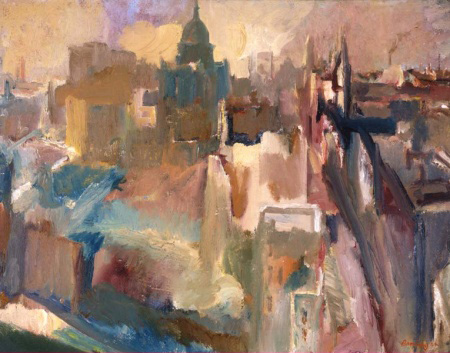 , showing the blitzed city viewed rising up to a triumphant, surviving St Paul's on the horizon, since described as the "most moving of all paintings of wartime Britain" (Martin Harrison); a series of flower paintings saturated with turbulent feeling; and his single commission as a war artist, a series of "Bomb Store" paintings (1942)
, showing the blitzed city viewed rising up to a triumphant, surviving St Paul's on the horizon, since described as the "most moving of all paintings of wartime Britain" (Martin Harrison); a series of flower paintings saturated with turbulent feeling; and his single commission as a war artist, a series of "Bomb Store" paintings (1942)  expressing Bomberg's expanded first-hand sense of the destructive powers of modern technology in warfare. These "Bomb Store" paintings convey a premonitory sense of the massive explosion that destroyed the underground store two years later, killing 68 people, and bear comparison with Piranesi's Carceri etchings.
expressing Bomberg's expanded first-hand sense of the destructive powers of modern technology in warfare. These "Bomb Store" paintings convey a premonitory sense of the massive explosion that destroyed the underground store two years later, killing 68 people, and bear comparison with Piranesi's Carceri etchings.
 A six-month stay at Odessa in the Soviet Union in the second half of 1933, following Hitler's seizure of power in Germany, led Bomberg on his return to London to immediate resignation from the Communist Party. During World War II, he painted Evening in the City of London (1944)
A six-month stay at Odessa in the Soviet Union in the second half of 1933, following Hitler's seizure of power in Germany, led Bomberg on his return to London to immediate resignation from the Communist Party. During World War II, he painted Evening in the City of London (1944) , showing the blitzed city viewed rising up to a triumphant, surviving St Paul's on the horizon, since described as the "most moving of all paintings of wartime Britain" (Martin Harrison); a series of flower paintings saturated with turbulent feeling; and his single commission as a war artist, a series of "Bomb Store" paintings (1942)
, showing the blitzed city viewed rising up to a triumphant, surviving St Paul's on the horizon, since described as the "most moving of all paintings of wartime Britain" (Martin Harrison); a series of flower paintings saturated with turbulent feeling; and his single commission as a war artist, a series of "Bomb Store" paintings (1942)  expressing Bomberg's expanded first-hand sense of the destructive powers of modern technology in warfare. These "Bomb Store" paintings convey a premonitory sense of the massive explosion that destroyed the underground store two years later, killing 68 people, and bear comparison with Piranesi's Carceri etchings.
expressing Bomberg's expanded first-hand sense of the destructive powers of modern technology in warfare. These "Bomb Store" paintings convey a premonitory sense of the massive explosion that destroyed the underground store two years later, killing 68 people, and bear comparison with Piranesi's Carceri etchings.
Unable to get a teaching position after World War II in any of the most prestigious London art schools, Bomberg became the most exemplary teacher of the immediate post-war period in Britain, working part-time in a bakery school at the Borough Polytechnic (now London South Bank University) in the working-class borough of Southwark. Though his students received no grant and were awarded no diploma, he attracted devoted and highly energetic pupils, with whom he exhibited on an equal basis in London,Oxford, and Cambridge in two important artists' groupings in which he was the leading light, the Borough Group (1946–51) and the Borough Bottega (1953–55). He developed a deeply considered philosophy of art, set out in several pieces of writing, which he summed up in the phrase, "The Spirit in the Mass".
Following a collapse in Ronda a city in the Spanish province of Málaga Bomberg died in London in 1957, his critical stock rising sharply thereafter. In the late 1950s one of Bomberg's admirers, the painter Patrick Swift , unearthed and edited Bomberg’s outspoken and apocalyptic pensées, and was later to publish them, along with images of Bomberg's work, as "The Bomberg papers" in his ‘X’ magazine.
, unearthed and edited Bomberg’s outspoken and apocalyptic pensées, and was later to publish them, along with images of Bomberg's work, as "The Bomberg papers" in his ‘X’ magazine.  After his early success before the First World War, he was in his lifetime the most brutally excluded artist in Britain. Having lived for years on the earnings of his second wife Lilian Holt and remittances from his sister Kitty, he died in absolute poverty.Rosenberg, Self-Portrait in a Steel Helmet, 1916. Private
After his early success before the First World War, he was in his lifetime the most brutally excluded artist in Britain. Having lived for years on the earnings of his second wife Lilian Holt and remittances from his sister Kitty, he died in absolute poverty.Rosenberg, Self-Portrait in a Steel Helmet, 1916. Private 
 , unearthed and edited Bomberg’s outspoken and apocalyptic pensées, and was later to publish them, along with images of Bomberg's work, as "The Bomberg papers" in his ‘X’ magazine.
, unearthed and edited Bomberg’s outspoken and apocalyptic pensées, and was later to publish them, along with images of Bomberg's work, as "The Bomberg papers" in his ‘X’ magazine.  After his early success before the First World War, he was in his lifetime the most brutally excluded artist in Britain. Having lived for years on the earnings of his second wife Lilian Holt and remittances from his sister Kitty, he died in absolute poverty.Rosenberg, Self-Portrait in a Steel Helmet, 1916. Private
After his early success before the First World War, he was in his lifetime the most brutally excluded artist in Britain. Having lived for years on the earnings of his second wife Lilian Holt and remittances from his sister Kitty, he died in absolute poverty.Rosenberg, Self-Portrait in a Steel Helmet, 1916. Private 
Thirty years after his death, a major retrospective of Bomberg's work was held at the Tate Gallery, London, in 1988.
In 2006, Abbot Hall Art Gallery in Kendal (Cumbria) mounted the first major exhibition of Bomberg's paintings for nearly twenty years: David Bomberg: Spirit in the Mass
mounted the first major exhibition of Bomberg's paintings for nearly twenty years: David Bomberg: Spirit in the Mass (17 July – 28 October 2006). Prior to that, the exhibition David Bomberg en Ronda at the Museo Joaquin Peinado in Ronda in Andalusia (1–30 October 2004) showed work by Bomberg in the city and environment which he had celebrated in paintings and drawings in 1934-35 and 1954-47. Work from one of the best collections in private hands was shown on the fiftieth anniversary of his death in the exhibition In celebration of David Bomberg 1890-1957 at Daniel Katz Gallery, Old Bond Street, London (30 May – 13 July 2007).
(17 July – 28 October 2006). Prior to that, the exhibition David Bomberg en Ronda at the Museo Joaquin Peinado in Ronda in Andalusia (1–30 October 2004) showed work by Bomberg in the city and environment which he had celebrated in paintings and drawings in 1934-35 and 1954-47. Work from one of the best collections in private hands was shown on the fiftieth anniversary of his death in the exhibition In celebration of David Bomberg 1890-1957 at Daniel Katz Gallery, Old Bond Street, London (30 May – 13 July 2007).
 mounted the first major exhibition of Bomberg's paintings for nearly twenty years: David Bomberg: Spirit in the Mass
mounted the first major exhibition of Bomberg's paintings for nearly twenty years: David Bomberg: Spirit in the Mass (17 July – 28 October 2006). Prior to that, the exhibition David Bomberg en Ronda at the Museo Joaquin Peinado in Ronda in Andalusia (1–30 October 2004) showed work by Bomberg in the city and environment which he had celebrated in paintings and drawings in 1934-35 and 1954-47. Work from one of the best collections in private hands was shown on the fiftieth anniversary of his death in the exhibition In celebration of David Bomberg 1890-1957 at Daniel Katz Gallery, Old Bond Street, London (30 May – 13 July 2007).
(17 July – 28 October 2006). Prior to that, the exhibition David Bomberg en Ronda at the Museo Joaquin Peinado in Ronda in Andalusia (1–30 October 2004) showed work by Bomberg in the city and environment which he had celebrated in paintings and drawings in 1934-35 and 1954-47. Work from one of the best collections in private hands was shown on the fiftieth anniversary of his death in the exhibition In celebration of David Bomberg 1890-1957 at Daniel Katz Gallery, Old Bond Street, London (30 May – 13 July 2007).
London South Bank University, the site of Bomberg's teaching at the former Borough Polytechnic, has received a gift of more than 150 paintings and drawings by Bomberg and his students in the Borough Group — principally Dorothy Mead, Cliff Holden, Miles Richmond(below), and Dennis Creffield — to be known as the David Bomberg Legacy. Construction of a gallery to house and exhibit this body of work is planned. A fundraising drive is under way to assist the University in this project.
and Dennis Creffield — to be known as the David Bomberg Legacy. Construction of a gallery to house and exhibit this body of work is planned. A fundraising drive is under way to assist the University in this project.
 and Dennis Creffield — to be known as the David Bomberg Legacy. Construction of a gallery to house and exhibit this body of work is planned. A fundraising drive is under way to assist the University in this project.
and Dennis Creffield — to be known as the David Bomberg Legacy. Construction of a gallery to house and exhibit this body of work is planned. A fundraising drive is under way to assist the University in this project.
The collection is the work of Sarah Rose, a friend of Cliff Holden of over 50 years. The Nasher Museum of Art at Duke University held an exhibition entitled The Vorticists: Rebel Artists in London and New York, 1914-18 from September 30, 2010 through January 2, 2011.

Tate Britain held an exhibition entitled The Vorticists: Manifesto for a Modern World between the 14th of June and the 4th of September 2011. In the 2011 BBC series, British Masters, Bomberg was singled out as being one of the greatest painters of the 20th Century
In December 1893, Sir Philip Magnus, a governor of the Borough Polytechnic Institute, now London South Bank University, proposed that a bakery school should be set up at the Polytechnic. During the following year Magnus visited a private bakery school run by a Mr John Blandy in Uxbridge (established 1889). He was impressed enough to invite Blandy to the Polytechnic for his advice on setting up a school for the technical and practical training of bakers. The scheme was approved by the London County Council Education Board in April 1894 and funds granted. On 10th October 1894 evening classes for Bakers and Confectioners were opened by Mr Henry C Kutz, President of the London Master Bakers' Protection Society.
In December 1893, Sir Philip Magnus, a governor of the Borough Polytechnic Institute, now London South Bank University, proposed that a bakery school should be set up at the Polytechnic. During the following year Magnus visited a private bakery school run by a Mr John Blandy in Uxbridge (established 1889). He was impressed enough to invite Blandy to the Polytechnic for his advice on setting up a school for the technical and practical training of bakers. The scheme was approved by the London County Council Education Board in April 1894 and funds granted. On 10th October 1894 evening classes for Bakers and Confectioners were opened by Mr Henry C Kutz, President of the London Master Bakers' Protection Society.
By 1898 bakers were the largest group in the Borough Polytechnic Institute's student body (142 students) and the success prompted John Blandy to propose that a national bakery school should be set up at the Polytechnic. The proposal prompted the National Association of Master Bakers (founded 1887) to take over the management of the Polytechnic's Bakery School on 25th September 1899 at their own cost. The bakery school was from then on formally known as the National School of Bakery and Confectionary.
The School continued its evening classes but now put a focus on its full-time day students, of whom six enrolled in the first term. On 5th February 1902 the foundation stone of new bakery buildings was laid by Thomas Fletcher of Birmingham Town Council, with John Humphry, President of the National Association of Master Bakers and Adam Lawson Johnston, Chairman of the Committee present. On 9 September of that year, the School's new buildings were opened by Alderman Francis Tonsley JP, President of the National Association of Master Bakers, supported by the Mayors of Northampton and Southwark, the Chairman of the Institute and its Governing Body. Mr John Kirkland was appointed Head of Department in the same year. On 10 September 1909 the new day session of the National School for Bakers and Confectioners was opened by the Lord Mayor of London, Sir George Wyatt Truscott with 44 full-time students borough poly where bomberg studied bakery as a means to stave off poverty.
borough poly where bomberg studied bakery as a means to stave off poverty.
A public art gallery dedicated to the work of influential British figurative artist David Bomberg and the Borough Group will be opened on Borough Road thanks to a grant of nearly £240,000 from the Heritage Lottery Fund
 borough poly where bomberg studied bakery as a means to stave off poverty.
borough poly where bomberg studied bakery as a means to stave off poverty.A public art gallery dedicated to the work of influential British figurative artist David Bomberg and the Borough Group will be opened on Borough Road thanks to a grant of nearly £240,000 from the Heritage Lottery Fund
No comments:
Post a Comment